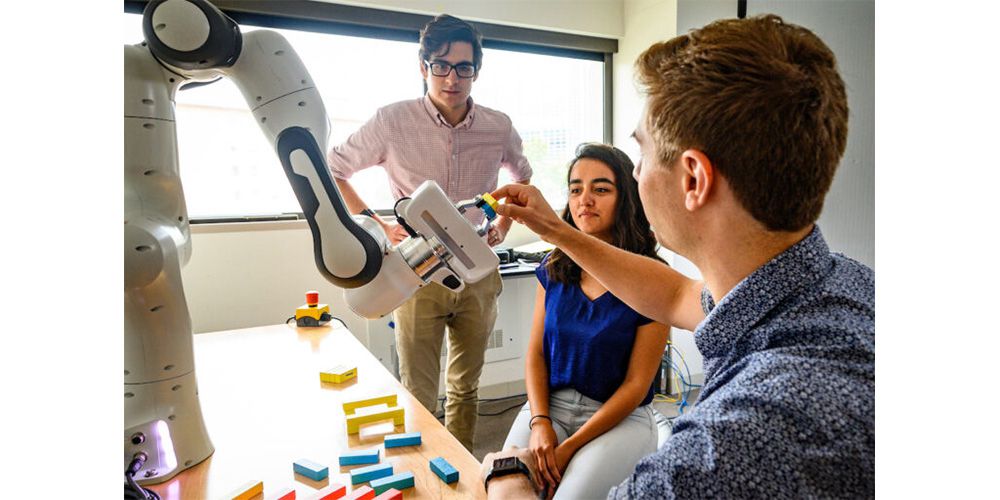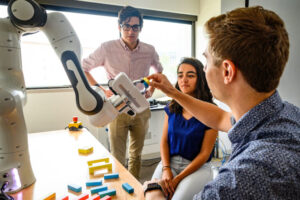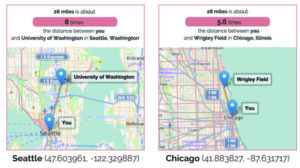
Imagine a world where workers have the ability to avoid life-threatening situations: A vulnerable human aerospace manufacturer once had to stand beneath the wing of a colossal aircraft, and now a life-sized robot takes their place in assembling the plane. The robot extends its mechanical arm, grasping tools in one hand while doing intricate work on a hefty engine in its other. A human operator stands far removed from the scene, wired with sensors and detective technology, allowing the robot to mirror the individual’s actions and safely completing what was once dangerous and backbreaking work.
At UW-Madison, this vision is becoming reality through the innovative research led by faculty in the UW-Madison School of Computer, Data & Information Science (CDIS). In a field of research known as Human-Computer Interaction (HCI), UW researchers are developing solutions that enable computer-based technology to improve our daily lives.
From projects involving spatially-aware robots to making life easier for those living with vision impairment, HCI research at UW-Madison aims to make technology more accessible while fostering efficiency in human-centered tasks.
Much of this research at UW-Madison is centralized in CDIS and includes faculty from the Computer Sciences Department and the Information School (iSchool). Efforts were started in 2009 by Computer Sciences professor Bilge Mutlu and now include five talented faculty members: Mutlu and Computer Sciences professors Yea-Seul Kim and Yuhang Zhao, along with iSchool professor Jacob-Thebault Spieker and Postdoctoral scholar Corey Jackson, who will join the faculty this fall.

“Any advanced, emerging technology will require a well-designed, well thought out way of interfacing with people,” Mutlu said. “HCI is critical at that juncture for effective human use and the well-being of people.”
For Mutlu, a typical day of research involves designing robotic technologies with the capacity to intimately interact with humans. A recent project with broad applications involved life-sized robots mirroring a remote human following a recipe. As the human poured ingredients, the robot followed along, mechanically grasping containers and completing sophisticated tasks.
According to Mutlu, this technology is now being applied to important modern scenarios, such as aircraft manufacturing in collaboration with aerospace company Boeing. In this case, a similar robot is controlled by a human worker, removing humans from dangerous assembly situations and replacing them with a robot mimicking the human’s actions.
While Mutlu is using HCI principles in robotic technology, the field is very broad. Additional HCI research in CDIS includes diverse projects aimed at fostering accessibility in both the physical and digital world, effectively using technology to improve people’s lives.

Professor Yea-Seul Kim is interested in developing ways to make it easier for people to understand the data that has become increasingly pervasive in modern society. One example of Kim’s research focused on making it easier for people to understand distance. She created interactive maps, offering personalized reference points to help people understand the proximity of these locations. With Kim’s technology, users are better able to decipher complicated maps and directions.
Professor Yuhang Zhao also aims to make the world easier to navigate by creating effective tools for individuals with impaired vision. Her research offers people with low-functioning vision new technology to virtually see aspects of daily life more clearly. Her newly-developed technology allows people to more easily navigate the physical world, including using stairs and facial recognition. In one case, she developed a cane controller that allowed blind people to experience a virtual reality, enabling blind users to navigate through virtual environments.
Though Computer Sciences is a key player in the realm of HCI, other fields of study, such as Information Science, influence fundamental aspects of the field, particularly involving the social implications of HCI.
iSchool postdoctoral scholar Corey Jackson is working to understand some of the HCI challenges related to the implementation of contact tracing technologies.
“We’re finding that the populations most impacted by COVID-19 have the lowest adoption of these technologies,” Jackson said. “If we want to achieve higher adoption we need to ensure that our approach to the design of technology is intersectional, encompassing the voices and needs of people from all races, socioeconomic classes, and gender identities.”
Faculty members across CDIS not only engage in in-depth HCI research, but they are also focused on educating the next generation of HCI researchers and professionals. The creation of CDIS in late 2019 expanded opportunities for students and faculty to explore their interests in HCI more broadly across departments.
“We can build these bridges across these different departments under CDIS to make this a strength at UW and a location for good HCI work across departments,” iSchool professor Jacob-Thebault Spieker said. “We can all benefit from these different perspectives in the HCI space.”
By Nicole Herzog
For more information about the School of Computer, Data and Information Sciences (CDIS) visit cdis.wisc.edu.